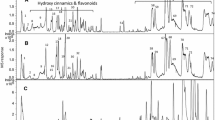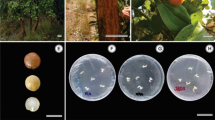Abstract
Cell suspension culture offers an approach for elucidating secondary metabolites biosynthetic pathways and its regulatory mechanism. In this work, Cinnamomum camphora (camphor tree) a plant enriched in essential oil components and employed in traditional medicine for the treatment of several conditions was subjected to callus induction. Callus growth was optimized in terms of medium type and concentration of plant growth regulators, revealing that Murashige and Skoog (MS) medium containing 2.0 mg L−1 naphthalene acetic acid plus 1.0 mg L−1 6-benzylaminopurine yielded the best combination for callus growth. Moreover, an MS-based metabolomics approach was used to compare volatile profile of intact leaf versus callus. Few reports in planta have addressed differences in volatiles composition between cell cultures (callus) and its original explants using such large scale analytical approaches. Headspace solid phase microextraction coupled to gas chromatography mass spectrometry was utilized to profile C. camphora leaf volatiles with a total of 47 volatiles including monoterpenoids viz., cineole and β-phellandrene as major constituents. In contrast, callus volatile profile showed qualitative and quantitative differences from that of leaf tissue and with its aroma being mostly dominated by aldehydes viz., benzaldehyde. Methyl jasmonate (MeJA) phytohormone elicitation effect was further applied with the aim of enhancing flavours volatiles production. Multivariate data analyses revealed that MeJA led to the upregulation of ionones production first time to be reported in C. comphora. This study extends our knowledge regarding ionones formation and to extend MeJA as a potential inducer of such flavour volatile class in planta.
Key message
Cinnamomum camphora was subjected to callus induction. A metabolomics approach was used to compare callus profile to that of leaf. MeJA elicitation upregulated ionones class first time to be reported.





Similar content being viewed by others
References
Belsito D, Bickers D, Bruze M, Calow P, Greim H, Hanifin J, Rogers A, Saurat J, Sipes I, Tagami H (2007) A toxicologic and dermatologic assessment of ionones when used as fragrance ingredients. Food Chem Toxicol 45(1):S130–S167
Broeckling CD, Reddy IR, Duran AL, Zhao X, Sumner LW (2006) MET-IDEA: data extraction tool for mass spectrometry-based metabolomics. Anal Chem 78(13):4334–4341
Chen AY, Chen YC (2013) A review of the dietary flavonoid, kaempferol on human health and cancer chemoprevention. Food Chem 138(4):2099–2107
Chen M, Ye Z, Ouyang S, Lin S, Shao A, Huang L (2010) Callus induction of Cinnamonum camphora and formation of borneol. Zhongguo Zhong yao za zhi = Zhongguo zhongyao zazhi = China. J Chin Mater Med 35(5):558–560
Chong-lu S, Huang K-Y, Cong-jin C, Zhang Y-Q (2006) Study on the extraction method of flavonoids in Cinnamomum camphora leaves and antioxidation property. J Chem Eng 7:001
Cooper CM, Davies NW, Menary RC (2009) Changes in some carotenoids and apocarotenoids during flower development in Boronia megastigma (Nees). J Agric Food Chem 57(4):1513–1520
Farag MA, El Sayed AM, El Banna A, Ruehmann S (2015a) Metabolomics reveals distinct methylation reaction in MeJA elicited Nigella sativa callus via UPLC–MS and chemometrics. Plant Cell Tissue Organ Cult 122(2):453–463
Farag MA, Rasheed DM, Kamal IM (2015b) Volatiles and primary metabolites profiling in two Hibiscus sabdariffa (roselle) cultivars via headspace SPME-GC-MS and chemometrics. Food Res Int 78:327–335
Farag MA, Mekky H, El-Masry S (2016) Metabolomics driven analysis of Erythrina lysistemon cell suspension culture in response to methyl jasmonate elicitation. J Adv Res 7(5):681–689
Farag MA, El-Kersh DM, Rasheed DM, Heiss AG (2017) Volatiles distribution in Nigella species (black cumin seeds) and in response to roasting as analyzed via solid-phase microextraction (SPME) coupled to chemometrics. Ind Crops Prod 108:564–571
Fiehn O (2016) Metabolomics by gas chromatography–mass spectrometry: combined targeted and untargeted profiling. Curr Protoc Mol Biol 14(1):30–34
Frizzo CD, Santos AC, Paroul N, Serafini LA, Dellacassa E, Lorenzo D, Moyna P (2000) Essential oils of camphor tree (Cinnamomum camphora nees & eberm) cultivated in Southern Brazil. Braz Arch Biol Technol 43(3):313–316
Fu J, Wang B, Gong D, Zeng C, Jiang Y, Zeng Z (2015) Camphor tree seed kernel oil reduces body fat deposition and improves blood lipids in rats. J Food Sci 80(8):H1912–H1917
Fuhrer T, Zamboni N (2015) High-throughput discovery metabolomics. Curr Opin Biotechnol 31:73–78
Guo X, Cui M, Deng M, Liu X, Huang X, Zhang X, Luo L (2017) Molecular differentiation of five Cinnamomum camphora chemotypes using desorption atmospheric pressure chemical ionization mass spectrometry of raw leaves. Sci Rep 7:46579
Gutiérrez-Coronado MA, Trejo-López C, Larqué-Saavedra A (1998) Effects of salicylic acid on the growth of roots and shoots in soybean. Plant Physiol Biochem 36(8):563–565
Han Y, Wu M, Cao L, Yuan W, Dong M, Wang X, Chen W, Shang F (2016) Characterization of OfWRKY3, a transcription factor that positively regulates the carotenoid cleavage dioxygenase gene OfCCD4 in Osmanthus fragrans. Plant Mol Biol 91(4–5):485–496
Hsieh T, Chen C, Lo W, Chen C (2006) Lignans from the stem of Cinnamomum camphora. Nat Prod Commun 1(1):21–25
Huang L-C, Huang B-L, Murashige T (1998) A micropropagation protocol for Cinnamomum camphora. In Vitro Cell Dev Biol-Plant 34(2):141–146
Hussein M (2002) In vitro propagation of three species of Aglaonema plants. Bull Fac Agric, Cairo Univ 53(3):465–487
Khalil MN, Fekry MI, Farag MA (2017) Metabolome based volatiles profiling in 13 date palm fruit varieties from Egypt via SPME GC–MS and chemometrics. Food Chem 217:171–181
Lalko J, Lapczynski A, McGinty D, Bhatia S, Letizia C, Api A (2007) Fragrance material review on 6-methyl-β-ionone. Food Chem Toxicol 45(1):S294–S296
Lee HJ, Hyun E-A, Yoon WJ, Kim BH, Rhee MH, Kang HK, Cho JY, Yoo ES (2006) In vitro anti-inflammatory and anti-oxidative effects of Cinnamomum camphora extracts. J Ethnopharmacol 103(2):208–216
Li Y-R, Fu C-S, Yang W-J, Wang X-L, Feng D, Wang X-N, Ren D-M, Lou H-X, Shen T (2018) Investigation of constituents from Cinnamomum camphora (L.) J. Presl and evaluation of their anti-inflammatory properties in lipopolysaccharide-stimulated RAW 264.7 macrophages. J Ethnopharmacol 221:37–47
Martin DM, Gershenzon J, Bohlmann J (2003) Induction of volatile terpene biosynthesis and diurnal emission by methyl jasmonate in foliage of Norway spruce. Plant Physiol 132(3):1586–1599
Murashige T, Skoog F (1962) A revised medium for rapid growth and bio assays with tobacco tissue cultures. Physiol Plant 15(3):473–497
Pastírová A, Repčák M, Eliašová A (2004) Salicylic acid induces changes of coumarin metabolites in Matricaria chamomilla L. Plant Sci 167(4):819–824
Peng L, Jiang Y (2006) Exogenous salicylic acid inhibits browning of fresh-cut Chinese water chestnut. Food Chem 94(4):535–540
Pragadheesh V, Saroj A, Yadav A, Chanotiya C, Alam M, Samad A (2013) Chemical characterization and antifungal activity of Cinnamomum camphora essential oil. Ind Crops Prod 49:628–633
Qualley AV, Dudareva N (2009) Metabolomics of plant volatiles. In: Plant systems biology. Springer, New York, pp 329–343
Shi J, Ma C, Qi D, Lv H, Yang T, Peng Q, Chen Z, Lin Z (2015) Transcriptional responses and flavor volatiles biosynthesis in methyl jasmonate-treated tea leaves. BMC Plant Biol 15(1):233
Singh R, Jawaid T (2012) Cinnamomum camphora (Kapur). Pharmacogn J 4(28):1–5
Staba EJ (1985) Milestones in plant tissue culture systems for the production of secondary products. J Nat Prod 48(2):203–209
Sumner LW, Lei Z, Nikolau BJ, Saito K (2015) Modern plant metabolomics: advanced natural product gene discoveries, improved technologies, and future prospects. Nat Prod Rep 32(2):212–229
Vaccaro M, Mariaevelina A, Malafronte N, De Tommasi N, Leone A (2017) Increasing the synthesis of bioactive abietane diterpenes in Salvia sclarea hairy roots by elicited transcriptional reprogramming. Plant Cell Rep 36(2):375–386
Vasil IK (2012) Phytochemicals in plant cell cultures. Elsevier, Amsterdam
Zhang X-N, Liu J, Liu Y, Wang Y, Abozeid A, Yu Z-G, Tang Z-H (2018) Metabolomics analysis reveals that ethylene and methyl jasmonate regulate different branch pathways to promote the accumulation of terpenoid indole alkaloids in Catharanthus roseus. J Nat Prod 81(2):335–342
Author information
Authors and Affiliations
Contributions
EA, MA and EE performed the callus experiments and quantified the data. AS analysed the results and wrote the paper. MAF performed volatiles analysis, data interpretation and edited the manuscript.
Corresponding author
Ethics declarations
Conflict of interest
The authors declare that they have no conflict of interest.
Additional information
Communicated by Mohammad Faisal.
Publisher’s Note
Springer Nature remains neutral with regard to jurisdictional claims in published maps and institutional affiliations.
Electronic supplementary material
Below is the link to the electronic supplementary material.
Rights and permissions
About this article
Cite this article
Abd El-Kader, E.M., Serag, A., Aref, M.S. et al. Metabolomics reveals ionones upregulation in MeJA elicited Cinnamomum camphora (camphor tree) cell culture. Plant Cell Tiss Organ Cult 137, 309–318 (2019). https://doi.org/10.1007/s11240-019-01572-z
Received:
Accepted:
Published:
Issue Date:
DOI: https://doi.org/10.1007/s11240-019-01572-z




